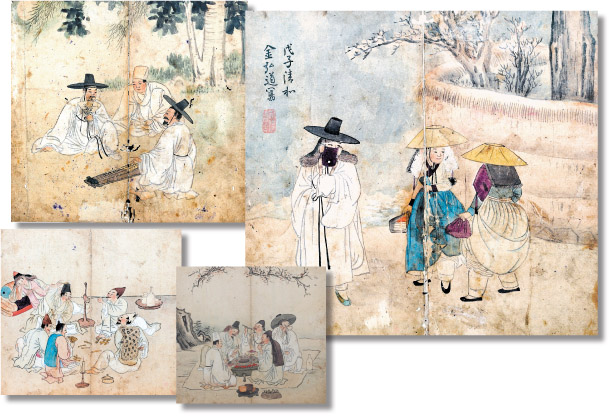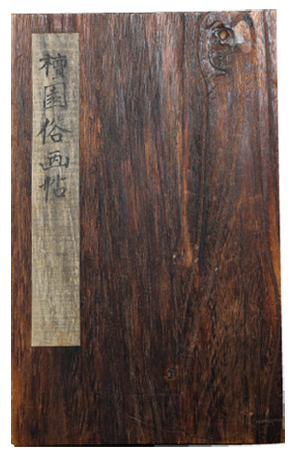Book of Danwon works revealed: Newly unveiled pieces thought to be the work of famous Joseon artist

Clockwise from top left: A seonbi (scholar) glances at two females, who are holding bojagi (traditional wrapping cloth), conversing with each other on the road. Five men enjoy eating meat outside in the spring, when plum blossoms bloom. In the winter, men gather around to gamble in a room lighted with an oil lamp and candles. A nobleman is playing the geomungo (six-stringed Korean zither), while his companions are listening. [JOONGANG ILBO]
The book, which has a wooden cover, contains seven genre paintings neatly folded in half. The majority of art experts have said that the pieces in the book are indeed the work of Kim, a versatile court painter famous for a wide variety of works. The book was published in 1768 and experts say it helps them understand the art history of the late Joseon period.
The seven paintings show ordinary happenings in daily life, such as noblemen talking and playing geomungo (Korea’s traditional string instrument) in the summer, grilling meat and drinking outside in the spring, and gambling in the fall.
The new album has been preserved and taken care of by the AB Gallery, located in Banpo-dong in Seocho District, southern Seoul.

“Danwonsokhwacheop”
“But because the benefactor thought that this album should be protected as a national treasure, it has been made public for the first time in 24 years.”
Sung said that there is writing in pencil in the back of the book which says that French priest Jacques Monieze received the album in April 1912.
Twenty-five genre paintings of Kim’s are included in the book titled “Album of Genre Paintings by Danwon,” which has been designated as Treasure No. 527. The exact date it was published is unknown, but it is assumed that Kim might have painted the works in his late 30s.
Some experts have found evidence that could prove the recently revealed book is filled with paintings actually made by Kim. Kang Woo-bang, the current head of the Ilhyang Korean Art History Research Center and the former general director of Gyeongju National Museum in North Gyeongsang, stated that the bright ambience of the paintings is distinctly Kim’s style.
“Although the album itself is old, the paintings still have a bright sensibility, which is very characteristic of artist Kim Hong-do’s paintings,” Kang said.
“Judging from the [artist’s] very vivid portrayal of people, alongside lines [that are not too rigid], the artwork seems to be authentic.”
At the back of the book, the phrase “Mujacheonghwa Kimhongdosa” is written alongside a stamp reading “Samcheongyeonwolhaw.” Muja signifies the year 1768 when Kim was 23 years old, and Cheonghwa means April, which is evidence art experts use to argue that this book really is by Kim. Samcheongyeonwolhwa is one of the phrases used in China’s Tang Dynasty poet Du Fu’s works.
“This artwork is extremely significant as these paintings were drawn in April 1786 when Kim was 23 years old,” commented Lee Jae-jun, a member of the Korean Art History Society and Korean Culture Society.
The seven paintings also show similarities with works by another Joseon-era artist named Seong Hyeop that are in possession of the National Museum of Korea. The paintings have similar structure and characters to that of Kim’s work. Lee said Seong seems to have copied Kim’s style in his paintings.
The term Kimhongdosa written in the book also brings up some questions. The Chinese character sa means either depicting something or copying something, making it unclear whether the paintings are actually by Kim or someone trying to imitate Kim.
With some of the features still in question, some scholars are cautious about calling these paintings the work of Kim.
“It is important to critically examine the artwork as it could be an imitation of Danwon’s genre paintings,” said Lee Won-bok, the director of Busan Museum.
BY CHO KANG-SOO [lee.jeonghyun@joongang.co.kr]
청년 김홍도 작품 추정 그림 7점…250년전 풍속화첩 첫 공개
조선 최고의 풍속화가인 단원(檀園) 김홍도가 20대 때 그린 작품으로 추정되는 풍속화 7점이 담긴 화첩이 9일 처음 공개됐다. 얇은 나무로 된 이 화첩은 30.5cmX28cm 크기의 그림을 반으로 접은 형태다. 표지에 '단원속화첩'이라고 쓰여 있다. 진품이라면 단원이 그린 지 250년만에 빛을 보는 셈이다.
지금까지 세상에 나온 김홍도의 풍속화는 국립중앙박물관이 소장중인 '단원풍속도첩'(보물 527호)에 실린 25첩이다. 그 풍속화들은 제작 연대가 불분명해 30대 후반에 그린 것으로 추정됐다. 이번에 발견된 화첩에는 연대가 정확히 기재돼 있어 단원과 조선 후기 풍속 미술사 규명에 귀중한 자료가 될 것이라고 전문가들은 평가한다.
이 풍속화첩을 보관·관리해온 서울 반포동 소재 AB갤러리 성석남(60·여) 관장은 "김홍도 풍속화첩은 1994년 3월 프랑스 최고 권위 경매장인 타장(Tajan) 옥션에 매물로 나온 것을 국내의 독지가가 당시 20만프랑에 구매해 소장하다가 국가 문화유산으로 보호해야 한다고 판단해 24년만에 처음 공개하는 것"이라며 "화첩 말미에 자크 모니에즈 프랑스 신부가 1912년 4월에 입수해 본국으로 가져갔다는 연필 글씨가 있다"고 말했다.
단원 풍속화첩은 수하탄주도, 출행도, 동자조어도, 마상유람도, 춘절야유도, 투전도, 남녀야행도 등 7장 14면으로 구성됐다. 여름철 사대부가 거문고를 탄주하며 담소를 나누는 장면, 봄철 술과 함께 고기를 구워 먹는 야유회 풍경, 겨울철 노름판 풍경 등이 해학적 표현과 함께 세밀하고 생생한 입체적 붓터치로 형상화돼 있다.
김홍도 작품 전시·기획 권위자로 국립경주박물관장을 지낸 강우방(77) 일향한국미술사연구원장은 "서첩이 오래됐음에도 그림의 분위기가 맑은데 그게 김홍도 그림의 특징이고 화풍"이라며 "세부적인 그림의 선이 무리가 없고 인물들의 얼굴이 살아 있어 진품으로 판단된다"고 말했다.
화첩 맨 끝장에는 '무자청화 김홍도사(戊子淸和 金弘道寫)'라는 묵기(墨記·붓글씨)와 '삼청연월화(杉淸延月華)'라는 도인(圖印)이 찍혀 있다. 무자는 조선 영조 44년(1768년), 단원이 23세 때다. 청화는 4월을 뜻한다. 삼청연월화는 김홍도가 흠모했던 당나라 시인 두보의 시 '자문(紫門)'의 한 구절이다.
한국미술사학회와 한국문화사학회 종신회원인 이재준 박사(69·전 충북도문화재 위원)는 "김홍도가 화첩의 그림들을 1768년 4월 23세 때 그렸다는 의미"라며 "특히 단원의 어린시절과 20대의 삶이 담긴 것으로 추정돼 연구 가치가 크다"고 말했다.
특히 이번에 발견된 7점은 국립중앙박물관이 소장하고 있는 조선후기 풍속화가 성협(成浹)의 풍속화들과 구도는 물론 등장인물이 똑같다. 이에 대해 이재준 박사는 "두 사람의 작품을 비교해 보면 품격이나 붓터치 면에서 성협이 김홍도의 그림을 모사한 것으로 보인다"며 "그동안 김홍도·김득신·김양기(김홍도의 아들)·성협으로 이어진 풍속화의 계보에 수정이 필요한 대목"이라고 지적했다.
이에 대해 이원복(64) 부산시립박물관장은 "이번 풍속화들을 사진으로 봤는데 단원의 화풍 특징을 잘 모사한 후학의 작품일 수 있으니 화첩이 흘러온 이력을 꼼꼼히 살펴봐야 한다"고 평가했다.
단원 풍속화첩의 유통 경로는=정조 44년(1768년)에 제작됐다. 1890년 대 한국에 나와 있던 자크 모니에즈 신부가 입수했다. 화첩엔 'Seoul april 1912'라고 연필로 적혀 있다. 당시 서울은 경성부로 불렸지만 영어로는 'Seoul'로 표기했다고 한다. 이 화첩이 다시 등장한 것은 1994년 3월 18일 프랑스 유명 경매업체인 '타장 옥션'이 드루오 호텔에서 개최한 한국 고미술품 경매를 통해서였다. 이전의 한국 고미술품 경매는 1929년 한국 초대 공사였던 프랑스인 꼴랭 드 쁠랑시가 소유한 미술품들을 파리에서 경매한 이후 두번째였다. 94년 경매에는 프랑소와 말레 부부가 소장하고 있던 157점의 한국 고미술품이 매물로 나왔다. 법원 공인 감정사인 띠에리 뽀르티에가 고미술품들을 감정했다. 타장 옥션이 펴낸 경매 물품 도록에는 김홍도 풍속화첩도 나와 있다. 경매 물품 126번으로 소개하며 춘절 야유도, 남녀 야행도의 사진을 실었다. 화첩에 대한 프랑스어 설명도 달았는데 마지막 단락은 한글과 한문으로 '7폭 畵帖, 문구: 檀園 金弘道 , 종이와 먹에 淡彩, 朝鮮時代'라고 적어놨다. 그 경매에서 조선시대 후기 초상화가 16만프랑, 청화백자가 11만 프랑에 팔렸고 김홍도 화첩은 20만 프랑 이상에 거래됐다고 한다. 당시 경매에 직접 참여해 낙찰받았다는 성석남 관장은 경매회사와 작성한 매매계약서, 경매 금액에 대한 지불 증서도 갖고 있다. 성 관장은 "그동안 은행 대여금고에 화첩을 보관해 왔다"며 "프랑스에서 경매로 외국인에게 넘어갈 수 있었던 것을 낙찰받아 해외문화유산 찾기에 일조한 셈"이라고 말했다. 그는 "익명을 원하는 소장자가 24년이 흐른 지금 공개하는 것은 우리 후손들에게 문화유산으로 남겨줄 때가 됐다고 판단했기 때문"이라고 소개했다.
조강수 기자










with the Korea JoongAng Daily
To write comments, please log in to one of the accounts.
Standards Board Policy (0/250자)